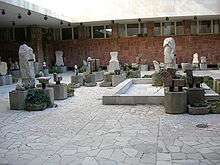Pazardzhik
| Pazardzhik Пазарджик | ||
|---|---|---|
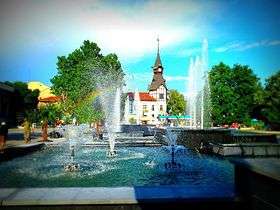 | ||
| ||
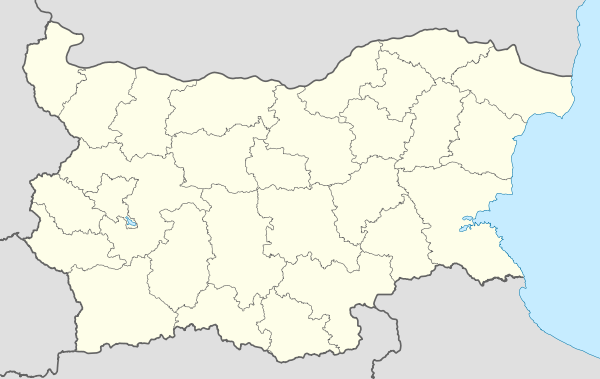 Pazardzhik Location of Pazardzhik | ||
| Coordinates: 42°12′N 24°20′E / 42.200°N 24.333°E | ||
| Country | Bulgaria | |
| Province (Oblast) | Pazardzhik | |
| Government | ||
| • Mayor | Todor Popov | |
| Area | ||
| • City | 37.382 km2 (14.433 sq mi) | |
| Elevation | 205 m (673 ft) | |
| Population (Census February 2011)[1] | ||
| • City | 71,979 | |
| • Density | 1,900/km2 (5,000/sq mi) | |
| • Urban | 114,817 | |
| Time zone | EET (UTC+2) | |
| • Summer (DST) | EEST (UTC+3) | |
| Postal Code | 4400 | |
| Area code(s) | 034 | |
| License plate | PA | |
| Website | Official website | |
Pazardzhik (Bulgarian: Пазарджик) is a city situated along the banks of the Maritsa river, Southern Bulgaria. It is the capital of Pazardzhik Province and centre for the homonymous Pazardzhik Municipality.
Name
The name comes from the word pazar, ultimately from the Persian bāzār, "market" + the Turkic diminutive suffix -cık, "small".
History
Pazardzhik was founded by Tatars from what is today Bilhorod-Dnistrovskyi in 1485 on the left bank of the river Maritsa, near the market of the region, an important crossroad at the middle of this productive region, and named Tatar Pazardzhik meaning "small Tatar market". Thanks to this favourable location, the settlement quickly developed. While it was very small at the beginning of the 19th century, it became the administrative centre for the region at the end of the century and remained so until the dissolution of Ottoman Empire.
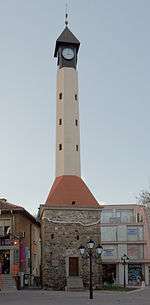
During the following centuries the town continued to grow and strengthened its position. Trade in iron, leather and rice prospered. The town impressed visitors with its beautiful houses and clean streets. In 1718 Gerard Kornelius Drish visited Pazardzhik and wrote "the buildings here according to construction, size and beauty stand higher than those of Niš, Sofia and all other places".
The Russians under Count Nikolay Kamensky took the city after a brief siege in 1810. By the mid-19th century Pazardzhik was a big, important centre of crafts and trade, with a population of about 25,000 people. It hosted two big annual fairs, and a big market Tuesdays and Wednesdays. There was a post office with a telegraph.
In 1837 the Church of the Mother of God was built – an important national monument, famous for its architecture and woodcarving. In the mid-19th century Pazardzhik became an important cultural centre: a school was opened in 1847, a girls' school in 1848, a community centre in 1868, the women's union "Prosveta" in 1870.
Pazardzhik is exempt from Zapdniya Russian detachment commander with Lt. Gen. Joseph Gurko on 14 January 1878 (new style). Thanks Ovanes Sovadzhiyan Armenian, Turkish command failed to execute his perfidious and monstrous plan – to light the town and destroy its Bulgarian population – before retiring.

From the early 20th century on people built factories, stores and houses, and thus the industrial quarter of the town. From 1959 to 1987 Pazardzhik was again an administrative centre for the region, and is again since the 1999 administrative division of Bulgaria.
Population
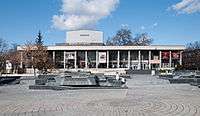
In the 1880s the population of Pazardzhik numbered about 15,000 inhabitants and it was one of the largest of Bulgaria.[2] Since then it started growing decade by decade, mostly because of the migrants from the rural areas and the surrounding smaller towns, reaching its peak in the period 1985–1992 exceeding 80,000.[3] After this time, the population has started decreasing in consequence of the poor economic situation in the Bulgarian provinces during the 1990s that led to a new migration in the direction of the country capital Sofia and abroad. As of February 2011, the city has a population of 71,979 inhabitants, while the Pazardzhik Municipality of 114,817 inhabitants.[1][3][4]
| Pazardzhik | |||||||||||||||
|---|---|---|---|---|---|---|---|---|---|---|---|---|---|---|---|
| Year | 1887 | 1910 | 1934 | 1946 | 1956 | 1965 | 1975 | 1985 | 1992 | 2001 | 2005 | 2009 | 2011 | 2013 | |
| Population | 15,659 | 18,098 | 23,228 | 30,376 | 39,499 | 55,430 | 65,727 | 77,340 | 82,578 | 79,476 | 76,161 | 75,346 | 71,979 | 70,728 | |
| Highest number ?? in ?? | |||||||||||||||
| Sources: National Statistical Institute,[1] „citypopulation.de“,[3] „pop-stat.mashke.org“,[4] Bulgarian Academy of Sciences[2] | |||||||||||||||
Ethnic linguistic and religious composition
According to the latest 2011 census data, the individuals declared their ethnic identity were distributed as follows:[5][6]
- Bulgarians: 57,332 (86.3%)
- Turks: 4,822 (7.3%)
- Gypsies: 3,423 (5.2%)
- Others: 325 (0.5%)
- Indefinable: 495 (0.7%)
- Undeclared: 5,582 (7.8%)
Total: 71,979
The ethnic composition of Pazardzhik Municipality is 89787 Bulgarians, 10132 Gypsies and 5686 Turks among others.
According to some reports, as of the middle 19th century the city is composed by 33 neighborhoods — 18 Turkish, 12 Bulgarian and 3 Gypsy. Although the Bulgarian neighborhoods were numerically smaller they were more densely populated, while there were Bulgarians in the Turkish neighborhoods too. In 1865 the population of the city was 25.000, Bulgarians comprised 57% of it and the Turks 28,5%.[7] As a trading town the city was attractive for other peoples and sizable minorities of Jews, Armenians and other peoples remained for decades, they are currently present although in much smaller numbers.
Culture and pedestrian areas
The Church of the Theotokos preserves the most impressive icons in Bulgaria by master artists of the Debar School, wood-carvings of New and Old Testament scenes, and icons by Stanislav Dospevski. Among the town's landmarks are also the clock tower, the ethnographic and history museums.
As with most Bulgarian cities, Pazardzhik has developed a significant pedestrian center, in which several central squares typify the European coffee house society and pedestrian culture. In Bulgaria the café culture is particularly prominent, with many downtown squares easily providing up to a half dozen cafés, with ample outside seating.
Pazardzhik has a level of pedestrian streets (or network of carfree areas) even above the relatively high Bulgarian standard. There are several longer pedestrian streets, and at one point there is even an intersection where five different pedestrian streets converge. A few of these do not continue for very long, but most do, or are connected to the rest of the pedestrian areas of the city, and thus could be said to form the pedestrian network of the city.
During the warmer seasons, most afternoons of the week and especially weekends find a large number of people strolling about or sitting in cafés. There are few tourist attractions in this area but there are large supermarkets including Bila and a Lidl.
Pazardzhik Point on Snow Island in the South Shetland Islands, Antarctica is named after Pazardzhik.[8]
International relations
Twin towns – Sister cities
Pazardzhik is twinned with:
-
 West Bend, Wisconsin, USA
West Bend, Wisconsin, USA -

.png) Stavropol, Russia
Stavropol, Russia -
 Chekhov, Moscow Oblast, Russia
Chekhov, Moscow Oblast, Russia -

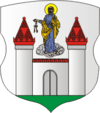 Barysaw, Belarus
Barysaw, Belarus -
 Salerno, Italy since 2011[9]
Salerno, Italy since 2011[9]
Promiment Citizens
- Konstantin Velichkov (1855-1905) - enlightener, poet, politician;
- Ivan Batakliev (1891-1973) - a geographer, historian;
- Stefan Zahariev (1810-1871) - Revival, educationalist;
- Ekaterina Mihailova (1956) - politician;
- Nicolas Digests (1903-1968) - poet;
- Serafim Todorov (1969 -) [10]
Gallery
 Old post building
Old post building- Street scene
 Stanislav Dospevski's house
Stanislav Dospevski's house Dormition of the Theotokos Church
Dormition of the Theotokos Church
References
- 1 2 3 (English) Bulgarian National Statistical Institute – towns in 2009
- 1 2 (Bulgarian) Bulgarian Academy of Sciences
- 1 2 3 (English) „WorldCityPopulation“
- 1 2 „pop-stat.mashke.org“
- ↑ (Bulgarian) Population on 01.02.2011 by provinces, municipalities, settlements and age; National Statistical Institute
- ↑ Population by province, municipality, settlement and ethnic identification, by 01.02.2011; Bulgarian National Statistical Institute (Bulgarian)
- ↑ Tatar Pazarcik in Encyclopaedia of Islam, Second Edition., Volume X, page 371, column 1: There were 8 Turkish schools with 500 pupils, 6 Bulgar schools with 530 pupils, and Jewish, Vlach and Armenian schools. The population is said to have amounted to 25,000 inhabitants, of whom Bulgars comprised 57% and Turks 28.5%.
- ↑ Composite Gazetteer of Antarctica: Pazardzhik Point.
- ↑ Cultural Twinning Salerno-Pazardzhik in 2011
- ↑ http://www.nytimes.com/2015/04/04/sports/the-last-man-to-beat-floyd-mayweather-jr-still-regrets-it.html?_r=0#
External links
| Wikimedia Commons has media related to Pazardzhik. |
- Pazardzhik municipality
 "Tatar Pazarjik". Encyclopædia Britannica (11th ed.). 1911.
"Tatar Pazarjik". Encyclopædia Britannica (11th ed.). 1911.
Coordinates: 42°12′N 24°20′E / 42.200°N 24.333°E

